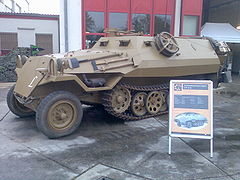Half-track

A half-track vehicle is a tracked vehicle with wheels and a track drive . In general, they have a steered front axle and a track drive instead of one or more rear axles . Half-track vehicles are usually counted as tractors .
The main advantage of caterpillars is their higher traction and cross-country mobility . They have a comparatively large contact area, which reduces the specific ground pressure for a given vehicle mass . Since the weight is distributed over the much larger area, the sinking of the vehicle is reduced, especially on soft ground.
In addition, the tracking of a chain drive is very good. In the case of a half-track vehicle, the steering is usually easier to implement, since the complex superimposed steering gear, which is otherwise necessary for tracked vehicles, can often be dispensed with.
High expectations were placed on this technology in the first half of the 20th century. The French manufacturer Citroën crossed the Sahara with half-track vehicles in 1922 (from Touggourt (Algeria) to Timbuktu ), in 1924/25 Africa ( Croisière Noire ) and 1931/32 Asia ( Croisière Jaune ). After World War II , half-track vehicles became quite rare; sometimes they can still be found in agriculture in mountainous areas.
The German Wehrmacht used many half-track vehicles during World War II, for example the medium-sized armored personnel carrier from Hanomag , for economic reasons: A half-track vehicle is cheaper to manufacture than a full-track vehicle, especially with an unbraked and non-driven front axle. The increase in length thus obtained allows a comparatively large usable space. The payload was usually surprisingly small (even an 18-ton tractor was only built for a payload of 2.8 tons), since the essential element of the towing vehicle was the pulling power based on the superior traction of the crawler drive, but these vehicles offered generally a solid basis for additions. As a result, it was even possible to mount artillery pieces (anti-tank guns, anti-aircraft machine guns) on quite light vehicle designs, which only caused the vehicle to sway moderately even with short firing sequences. Another reason was the shorter training time for drivers compared to pure tracked vehicles; this factor was also reflected in the design of the driver's cab, which was based on a normal truck. In the later course of the 20th century, the training factor became increasingly obsolete, as the spread of the automobile advanced and drivers no longer had to be thoroughly trained.
Half-track vehicles initially had no traction that could be differentiated from one side to the other (which is essential for steering in a full-track vehicle), but were only controlled with the front axle with tires. The German half-track vehicles of the Second World War were an exception, as the steering effect only through the front axle in the field turned out to be completely inadequate due to the relatively large chain contact lengths; For example, 2860 mm for the 18-ton tractor and 1800 mm for the medium-sized SPW (for comparison: the US standard armored personnel carrier M3 , the counterpart of about the same size in the Allies, this value was only 1187 mm, so its powered and clearly more heavily loaded front axle steer the vehicle sufficiently). However, the advantages achieved through lower consumption and wear and tear and superior off-road mobility were offset by the more complex maintenance of the steering brake system in the field.
The Air Force used the of during World War NSU developed Kettenkrad as a tractor to move aircraft between shelters and waiting positions.
Halftrack based on the American armored personnel carrier M3 , May 1993, Cromer, Renosteel Construction Ltd.
German 1-ton tractor in World War II, equipped for laying telephone cables, 1941
OT-810 from the Czech Škoda works
literature
- Heinrich Buschmann, Paul Koeßler (Hrsg.): Pocket book for the motor vehicle engineer . 7th edition, Deutsche Verlags Anstalt, 1963.
- Georg Garbotz : Manual of mechanical engineering in construction . Volume 3, Part 1, Springer Verlag Berlin Heidelberg GmbH, Berlin Heidelberg 1937.
- Ulrich Cimolino , Thomas Zawadke (ed.): Emergency vehicles for fire and rescue services . 1st edition, Hüthing Jehle Rehm GmbH publishing group, Landsberg 2006, ISBN 978-3-609-68667-7 .
Web links
- Die Welt Online: Half-track vehicles were symbols of doom (accessed on May 20, 2016)





